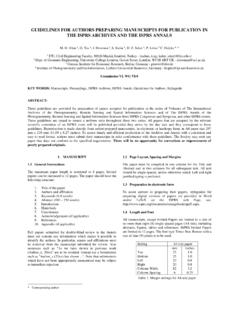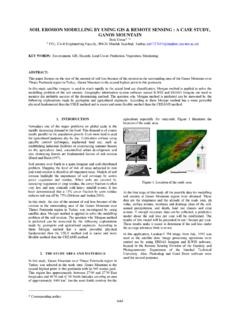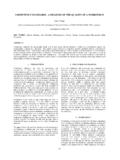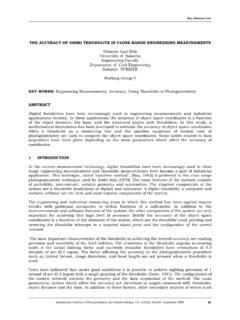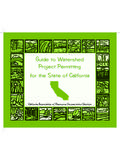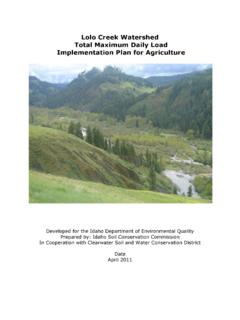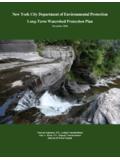Transcription of Introduction Watershed Management
1 Introduction Watershed Management Lal Samarakoon Director, Geoinformatics Center, AIT. Senior Scientist, JAXA. What is a Watershed ? A Watershed . Refers to a Particular Location and a Spatial Extent, Gravitationally Draining Through that Location. A Topographically Delineated Area that is Drained by a Stream System A Hydrological Unit used for Planning and Management of Natural Resources 1. Water Cycle Watershed Management 9 This is the PROCESS of GUIDING & ORGANISING, Land and Other Resource Usage in a Watershed Ensuring the Sustenance of the Environment (Mainly the Soil and Water Resources). ie., need to recognise the interrelationships between, LAND USE, SOIL-WATER, and SLOPE OF TERAIN. 9 Unifying Focus in Watershed Management is in how various human activities affect the relationship between water and other natural resources 9 Provides a basis for actions concerning the development and conservation 2.
2 Integrated Watershed Management Real World > Dis-aggregated, Independent, Political Actions The tendency or inclination > Implementation in an Independent Fashion with little or no regard to how they affect other areas. However, Water Flows Down the Slopes and Ignores the Political or Administrative Boundaries Therefore Upstream Activities by a Person or a Group of Persons Affect the Welfare of those in the Downstream This Gives Rise to the Need of Bringing together THE PHYSICAL. FACTORS of a Watershed and The SURROUNDING POLITICAL REALITIES. Watershed Management Concerns PREVENTING deterioration of existing relationships between the use of natural resources within a Watershed RESTORING sustainable relationships which had been destroyed due to actions in the past THERE BY ENSURE THE BEST USE OF. RESOURCES IN A Watershed . 3. Watershed Management Strategies 9 PREVENTION STRATERGIES.
3 - Those Aimed at Preserving Suitable Existing Land Use Practices 9 RESTORATIVE STRATEGIES. - Those Targeting to Overcome Identified Problems or to restore conditions to a Desirable level both Environmentally and Politically Problems Associated with Watersheds Flooding .Unstable Slopes / Land Slides .Erosion from Denuded Land .Deficient Water Supplies .Energy Shortage .Food Shortage .Poor Quality Drinking Water .Polluted Streams / Reduced Fishing .Sedimentation of Navigation Tracks..Timber Shortage (for Dwelling Purposes). 4. Problems and Possible Interaction Flooding Flood Control Reservoirs, Construction of Levees Flood Plain Management Re-vegetation(Denuded Areas). Unstable Slopes / Land Slides Slope Protection &. Drainage Structures Erosion Erosion Control Structures Contour Terracing Re-Vegetation Deficient Water Supplies Storage Reservoirs Water Harvesting Vegetation Manipulation Pumping of Deep Groundwater Problems and Possible Interaction Energy Shortage Fuel Wood Harvesting Hydro-Power Development Food Shortage Develop Agricultural Areas Develop Agricultural Practices Increase Livestock Poor Quality Drinking Water Develop Wells and Springs Treat Water Polluted Streams / Reduced Fishery Control Pollutant Entry Treat Wastewater Sedimentation of Navigation Tracks Erosion Control Structures Dredging and Mining Timber Shortage - Timber Harvesting 5.
4 Watershed Management Measures Soil Preservation/Enhancement . Erosion . Structural Status . Biological Vegetation Preservation/ Enhancement Watershed . Bio mass Quantity Management . Bio mass Quality Water Preservation / Enhancement . Flood Peaks/River flows . Groundwater Recharge . Sediment loads . Pollutants Solution Associated with Watershed Management Flooding Flood Control Reservoirs Minimise sedimentation Manage Land Cover Construction of Levees Minimise Sediments Flood Plain Management Land use Zoning/ Management Re-vegetation Manage Land Cover Unstable Slopes / Land Slides Slope Protection Structures for Stabilise Slopes Manage Land Cover Restructure Slopes (Terracing etc.). Drainage Management Erosion from Denuded Lands Erosion Control Structures Re-vegetation & Management Contour Terracing Re-vegetate, Mulching Slope Stabilisation, Re-vegetate Protect and Manage Vegetative Cover 6.
5 Watershed Management Measures Soil Preservation/Enhancement . Erosion . Structural Status . Biological Vegetation Preservation/ Enhancement . Bio mass Quantity Hydrology . Bio mass Quality Related Factors Water Preservation / Enhancement . Flood Peaks/River flows . Groundwater Recharge . Sediment loads . Pollutants Hydrological factors in relation to Watershed Management 9 Precipitation and Interception 9 Evapo-transpiration and Soil Moisture Storage 9 Infiltration Runoff And Stream flow 9 Groundwater 7. Precipitation & Interception 9 Affects the Amount, Timing and Spatial Distribution of Water Added to a Watershed from the Atmosphere 9 Precipitation is Largely beyond Human Control Land Use and Associated Vegetation Alterations affect the Deposition of Water by Changing Interception (Type, Extent, and Condition of Vegetative Land Cover Influence the Pattern and the Amount Reaching the Soil Surface).
6 9 Dense Coniferous Forests and Multi-Storied Canopies of Tropical Forests Intercept and Store Significant Quantities of Precipitation and a Substantial Quantity is Returned to Atmosphere as Evaporation (Approx 30%). Evapotranspiration & Soil Moisture 9 Evaporation from Soils, Plants Surfaces, and Water Bodies together with Water Transpired through Plant Leaves is called Evapotranspiration 9 Larger Canopied Plants Transpire Larger Amounts compared to Bare Soil or Plants with Smaller Stature 9ET affects the Water Yield, and Largely Determines the Proportion of Precipitation input becoming Streamflow 9In Tropical Watersheds ET component Reaches upto 80%. 9 Annual ET computations are through Water Balance Computations 8. Comparison of Annual ET and RF. Precipitation ET as a % of Evapotransp iration (mm). Location Country Annual Annual (mm). RF. Thailand N1 1337 (78-87) 725 54%.
7 P14 941 (78-87) 692 74%. P21 935 (78-87) 676 72%. X53 1799 (78-87) 534 30%. X67 1803 (78-87) 1228 68%. CT4 1219 (78-87) 943 77%. N40 1387 (78-87) 10221 74%. E54 1458 (78-87) 751 52%. E29 1367 (78-87) 1064 78%. M69 1591 (78-87) 950 60%. Malaysia Lengkuas 2139 (61-67) 1643 77%. Victoria 2578 (61-67) 1689 66%. 2197 (72-79) 1412 64%. Sri Peradeniya 2726 (69-80) 826 30%. Lanka Putupaula 3480 (72-79) 795 23%. Bopagoda 3324 (up to 96) 1952 58%. Chilaw 1604 (up to 96) 536 33%. Katharagama 1522 (up to 96) 1240 82%. Dambulla 1278 (up to 96) 986 77%. Infiltration, Runoff & Streamflow Rain Water Reaching the Ground, either 9 Fills Depressions 9 Moves into the Soil or 9 Flows Over the Surface Water Which Enters the Soil, either 9 Moves Downward to a Groundwater Aquifer or 9 Moves Downwards and Laterally to Stream Channels The Rate at Which Water Enters the Soil is Governed by 9 Surface Conditions ( Exposed, Compacted) & Land Cover (Vegetated,Impervious etc.)
8 9 Physical Conditions of Soil (Porosity, Hydraulic Conductivity, Current Moisture Content). 9. Infiltration, Runoff & Streamflow 9 Soil Covered with Vegetation Encourages Higher Infiltration than Bare Soils (Detainment). 9 Plants through Canopy Cover reduces the Rain Drop Impact which can seal the Surface by Displacing Tiny Particles into Soil Pores 9 Rainwater which flows over the surface and which flows laterally through the Soil becomes Streamflow 9 The Terrain Shape and Constituents determine the Time and Quantity of Streamflow Generated in a Watershed 9 Watershed Characteristics such as, Shape, Size, Channel and Watershed Slope, Topography and Drainage Density, and the Presence of Wetlands and Reservoirs influence the Streamflow Response Infiltration, Runoff & Streamflow Water Yield from a Catchments Usually Increases when, 9 Forests are Clear Cut or Thinned 9 Vegetation converted from Deep Rooted to Shallow Rooted 9 Change of Plant Species with High Interception Capacities to Low Interception Capacities LARGEST WATER YIELD OCCURS FROM CLEAR.
9 CUTTING OF FORESTS. 10. Infiltration for Different Vegetation Conditions (Morocco). Heavily Moderately Ungrazed Grazed Grazed Afforested Palm Brushland Pine Vegetation Vegetative 99. Cover (%). Slope (%) 0-10 5-25 5-40. Initial 179 194 439. Infiltration Rate (mm/hr). Infiltration 43 65 226. Rate after 2hrs (mm/hr). Increase of Water Yield with reduction in Vegetation Cover Increase in Water Yield per 10%. Vegetative Reduction in Cover Cover Type Average Maximum Minimum (mm) (mm) (mm). Conifer & 40 65 20. Eucalyptus Deciduous 25 40 6. Hardwood Shrub 10 20 1. 11. Ground Water Groundwater is referred to as the water that is accumulated beneath the Soil Surface in Saturated Zones Groundwater is very important to maintain the Watershed Wetness but it Seldom Occurs where it is most needed Groundwater is often used as a Source of Fresh Water and important for vegetation sustenance and /or vegetation revival Groundwater that seeps into streams provides the Baseflow of Streams.
10 Therefore any unmanaged use would create a heap of Environmental Problems. In most watersheds the use of Groundwater is limited by the Rate of Natural Replenishment. There are many places where Natural flood waters are used to replenish the Groundwater Soil Erosion and Sedimentation Soil Erosion The Process of Dislodgement and Transport of Soil Particles by Wind and Water Factors affecting Soil Erosion are, Climate, Topography, Soil Characteristics, Vegetative Cover, Land Use etc. Concerns of Wind Erosion Significant only in Arid and Coastal Areas Major Concern throughout the World (Especially in the TROPICS) is the Soil Erosion by Water Erosion Rates In Undisturbed Forests - tons/ha/year Logging and Roads - in excess of 15 t/ha/yr Road Construction Sites - excess of 95 t/ha/yr 12. Factors Associated with Soil Erosion &. Sediment Transport Rainfall, Runoff, Wind, Climate Temperature Grain Size Shape etc.
